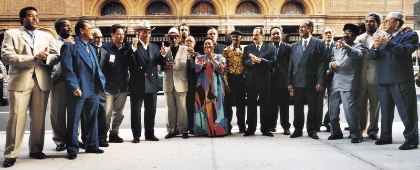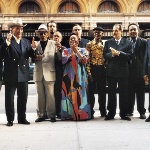
Songs
- country:Cuba
- style(s):Cuban
- label:World Circuit Ltd.
- type:Band
- artist posted by:World Circuit Records
Links
As Cuban revolutions go, it was an entirely peaceable uprising - but its impact could not have been more profound. On the release of the Buena Vista Social Club album in 1997, few outside the specialist world music audience initially took much notice of the record's elegantly sculpted tunes and warm, acoustic rhythms. Then something extraordinary occurred. The album was spectacularly reviewed by a few discerning critics, but although their words of praise did Buena Vista's cause no harm, they cannot explain what subsequently happened. Good reviews create an early surge in sales, but unless it's a big pop release sustained by an expensive TV advertising campaign, the established pattern is that interest then slowly tails off. Instead, Buena Vista's sales figures kept steadily rising week by week, building almost entirely by word-of-mouth until it achieved critical mass: all who heard the record not only fell in love with Buena Vista's irresistible magic, but were then inspired to play or recommend the album to everyone they knew. It was one of those rare records that transcended the vagaries of fad and fashion to sound timeless but utterly fresh. Once you heard it, you had to have a heart of stone not to be swept away by the music's romantic impulses and uninhibited exuberance.
That its impact had made waves far beyond the specialist world music audience was soon self-evident. Buena Vista went on to win a Grammy and its crossover success persuaded the acclaimed director Wim Wenders to make an award-winning feature film about the phenomenon. As Nick Gold, whose World Circuit label released the record, put it : "Buena Vista was a once-in-a-lifetime thing. We knew we'd made a special record but nobody could have imagined how it would take off."
The record's success launched what can only be described as Cuba-mania, helping to inspire a thousand salsa dance classes and Cuban-themed bars on every high street. At its peak, it seemed that you couldn't move without hearing Buena Vista's potent, captivating soundtrack : in coffee shops and mojito bars and even department stores and elevators songs such as Chan Chan, Dos Gardenias and Candela came to accompany our daily existence. Suddenly, Buena Vista was not so much a record as a brand, albeit one based on musical quality rather than marketing hype. Even Salman Rushdie, in his New York novel Fury, paid tribute to its all-pervasive power, describing the long, hot days of 1998 as "that Buena Vista summer".
On the album's release, Nick Gold had hoped that, given a fair wind, Buena Vista might sell 100,000 copies - a highly respectable figure in the specialist world music field. Today the album's global sales stand at over eight million, making it the biggest-selling Cuban album in history. As one critic put it, Buena Vista has become "world music's equivalent of The Dark Side of the Moon."
Yet few could have predicted this iconic success when the veteran musicians who recorded Buena Vista assembled in the run-down Egrem studio in Havana in 1996. They weren't even a formal group, but a loose collective, spanning several generations and assembled more-or-less spontaneously for the occasion. Indeed, the group that came together was in essence an accident: the original intention had been to make an experimental hybrid record bringing together African and Cuban musicians, but the African musicians failed to turn up because of visa problems. In fact the original idea had been to record not one but two albums. The first was Juan de Marcos Gonzalez' dream project - an album celebrating the continued vitality of Cuban music's golden age - the 1940's and 1950's. He hand-picked and recruited a multi-generational big band which he called the Afro Cuban All Stars and in a week they had recorded their brilliant debut album 'A Toda Cuba le Gusta' ('All Of Cuba Likes It'). The following day recording of the Mali - Cuba collaboration album was due to start, but as the Africans were unavailable World Circuit's Nick Gold, American Producer Ry Cooder and band leader Juan de Marcos were forced to improvise.
The veteran pianist Ruben Gonzalez, who didn't own a piano at the time had been persuaded out of retirement by Juan de Marcos for the All Stars album. Not that it took much coaxing: despite his years of inactivity, his playing was on fire and so eager was he to get to the piano that every morning when the janitor turned up to unlock the studio doors, he was already waiting outside. The singer Ibrahim Ferrer, who was scraping a living shining shoes and selling lottery tickets, was also rescued from obscurity - and proceeded to sing his heart out. Eliades Ochoa the great guitarist and singer provided the rural roots from Santiago. Omara Portuondo was recruited as the company's leading lady and the rich, resonant voice of the 89 year-old Compay Segundo provided a link with Cuba's deepest musical past. "He knew the best songs and how to do them because he'd been doing it since World War One," as Ry Cooder noted.
Yet this stellar line-up of singers was only part of the story. Behind them were some of the finest musicians Cuba had to offer, including the bassist Orlando 'Cachaito' Lopez, who provided the heartbeart, trumpet player Manuel 'Guajiro' Mirabal, who added the flair, and Barbarito Torres the virtuoso laoud player. In the space of two weeks World Circuit's Havana recording blitz produced not only the Afro Cuban All Stars and the Buena Vista Social Club albums but also the debut solo album by Ruben Gonzalez.
When they had finished recording, Ry Cooder knew that he had been privileged to be part of a unique musical experience. "This is the best thing I was ever involved in," he said prior to Buena Vista's release in June 1997. "It's the peak, a music that takes care of you and nurtures you. I felt that I had trained all my life for this experience and it was a blessed thing."
In Cuba, he noted, he had found the kind of deeply rooted musical context that he had been searching for all his life. "These are the greatest musicians alive on the planet today," he enthused. "In my experience Cuban musicians are unique. The organisation of the musical group is perfectly understood. There is no ego, no jockeying for position so they have evolved the perfect ensemble concept."
Following the recordings, the musicians hit the road and extensive tours were undertaken by Ruben Gonzalez, Ibrahim Ferrer, the Afro Cuban All Stars, Eliades Ochoa, Omara Portuondo and Compay Segundo. The original line up of the Buena Vista Social Club made three triumphant concert appearances; two at Amsterdam's Carre Theatre and the final legendary show at New York's Carnegie Hall. The latter was filmed by Wim Wenders as the climax of his successful documentary also named "Buena Vista Social Club", and the concert recording was released ten years later as "Buena Vista Social Club(r) at Carnegie Hall". Over the years World Circuit has continued to travel to Havana recording acclaimed albums by Ibrahim Ferrer, Omara Portuondo, Ruben Gonzalez, Cachaito Lopez, Guajiro Mirabal and Anga Diaz, who had been an integral part of the Afro Cuban All Stars.
Sadly, several of the group's aging stars, including Compay Segundo, Ruben Gonzalez and Ibrahim Ferrer are no longer with us. But the timeless, magical music that created the Buena Vista legend lives on. Omara Portuondo has been extremely busy having recorded two albums, one with Brazilian star Maria Bethania and a solo album due for release in autumn 2008; her tours continue to sell out concert halls around the world. Juan de Marcos Gonzalez is ever active: working on musical productions in Mexico and forming a new edition of the Afro Cuban All Stars. Eliades Ochoa embarks on a new European tour in the autumn of 2008 and has been working on material for a new solo album. Cachaito Lopez, Guajiro Mirabal, Aguaje Ramos, Manuel Galban, Amadito Valdes and Barbarito Torres are touring the world to great acclaim as part of the Orquesta Buena Vista Social Club.


